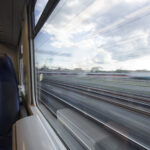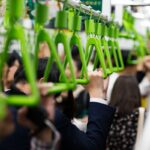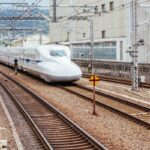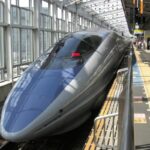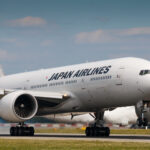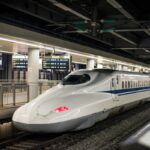Japan’s public transportation system is known around the world for its efficiency and orderliness. For those traveling to Japan, it’s something truly exhilarating to experience: standing on the platform, waiting for a bullet train to arrive and take you to a far-off destination.
Japan’s famous high-speed trains—called Shinkansen—are operated by Japan Railways (JR). These trains hit speeds of up to nearly 200 miles per hour, and they’re famous for their consistent on-time arrivals. Shinkansen bullet trains aren’t just fast; they’re also comfortable, spacious, safe and efficient. This is due in large part to the etiquette that riders share. Part of using Japan’s bullet trains is learning what is (and isn’t) appropriate when it comes to riding them.
If you’re a tourist in Japan or new to the country, here’s what you need to know about Japan’s unique and most popular form of public transportation—from purchasing tickets to being a courteous rider.
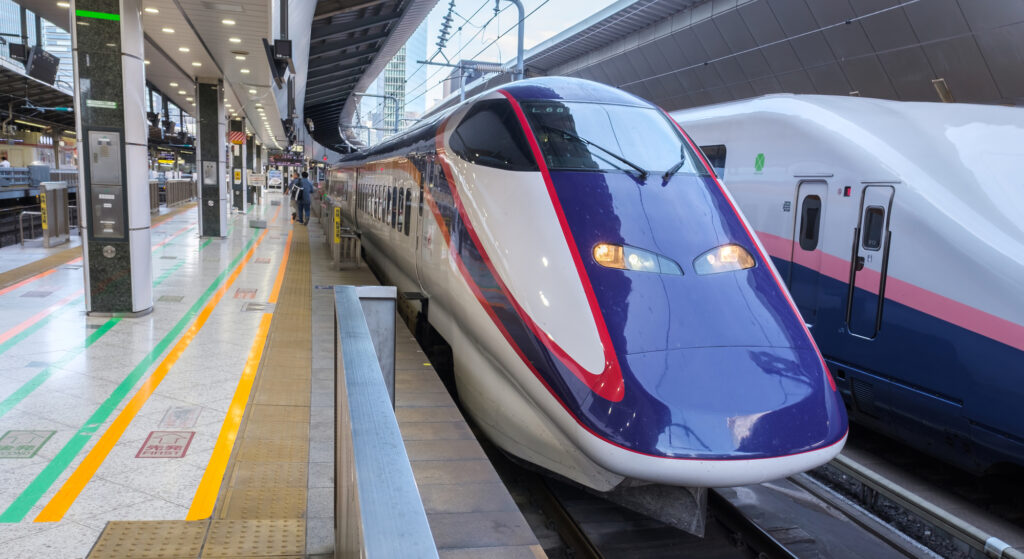
Are Shinkansen safe for tourists?
Japan is an incredibly safe country for tourists and locals alike, and its public transportation system is no exception. Shinkansen trains are very safe for tourists and, unlike some public transportation experiences in other countries, riding the bullet train is comfortable and even enjoyable. Most people keep to themselves on the train, and cars are often quiet with a relaxed atmosphere.
The bullet train is safe in and of itself, boasting a clear record with no accidents since its creation in 1964. You can have peace of mind you’ll get to your destination safely—and always on time. There’s also virtually no crime aboard trains, so you won’t need to worry about someone snatching your luggage or walking off with your valuables. Theft is extremely scarce in Japan, and on public transit especially.
A look at the Shinkansen Network
Much like railways systems in other countries, there are several bullet train lines to choose from depending on where you want to go in Japan. These lines all fall under the greater Shinkansen Network, which stretches all across Japan’s major economic hubs.
The Tokaido Shinkansen (Tokyo-Nagoya-Kyoto-Osaka) is the oldest and most popular line, transporting millions of people every day. Other than the Akita and Yamagata Shinkansen, the lines run on tracks exclusively built for these special bullet trains (See also: “How Fast Is The Bullet Train From Tokyo To Kyoto“). Several lines are served by multiple train categories, from slower models that stop at every station, to super-fast models that stop only at major stations.
It’s a good idea to get familiar with the major lines and the prominent stops on each line before boarding a Shinkansen train. Tourists are advised to always have a map with them, or to use their phone to look up the proper route from one destination to the next.
What to know about riding the bullet train
While every train differs from line to line, Japan’s Shinkansen offer reserved and non-reserved seats, as well as different seat classes. Before you buy your ticket, make sure you’re getting the seat you want, so you’ll stay comfortable on your journey. Prices vary depending on the line and the seat, and the level of amenities you’re willing to pay for.
Here’s what you need to know about riding the rails when it comes to reserved seating and special ticket classes:
Shinkansen seat classes
There are two seat classes on most trains—ordinary and “Green Car.” Ordinary seats are the regular seats found on all Shinkansen trains, but the size and space depend on the particular train you’re riding. Green Car seats are comparable to First Class on airplanes, offering larger and more comfortable seats than you’ll find in the ordinary class. These cars also tend to be quieter, usually occupied by individuals who are going further
Reserved vs. non-reserved
Most Shinkansen trains have non-reserved and reserved seats in separate cars. It usually costs a few hundred yen to place a reservation, but Japan Rail Pass holders can place them free of charge (see also “How Much Does The Bullet Train Cost From Tokyo To Kyoto?“). Some particular trains—including the Hayabusa, Hayate, Komachi and Tsubasa trains on the Tohoku and Hokkaido lines, as well as the Kagayaki trains on the Hokiruku line—are fully reserved, so book your seats in advance if you’re planning to travel on these lines.
One quick note that applies to all seats: Wi-Fi is generally free for all ticketholders. If you’re looking to do some browsing between stops, you’ll have the convenience of Shinkansen Wi-Fi to keep you connected for the duration of your journey. Just be sure to put your headphones on or turn the sound off on your devices!
How to buy tickets for the bullet train
Buying Shinkansen tickets can be tricky, especially if you’re still learning to read and speak Japanese. Thankfully, there are several ways to procure ticket without too much trouble. Here’s how you can buy tickets for the bullet train:
- At the counter. You can buy Shinkansen tickets at any ticket office at all major (and many minor) JR stations across the country. You’re free to pay with a credit card at these offices. You’ll need to provide a variety of information, including the number of travelers; date of departure; departure and destination station; ordinary or green car; and reserved or non-reserved seats. If you don’t speak Japanese, write this information on a piece of paper and present it to the ticket person to make the process easier.
- At a kiosk. Some ticketing kiosks offer Shinkansen tickets, and many of them even feature English directions. Keep in mind that the process of buying tickets isn’t always simple, and some machines only accept Japanese-issued credit cards. Some major stations will have attendants near kiosks, to help people expedite their ticket purchases, or to answer questions.
- Online. Unfortunately, there’s no English website for buying Shinkansen tickets. You’ll need to use individual reservation systems and services that cover the line you need to travel on. These systems don’t issue e-tickets—you’ll need to physically pick them up from ticket machines before you board the train.
While it may seem simplest to buy online, the best option for visitors and first-time rail riders is often to purchase tickets at a ticket counter at the station. If you’re going to be a long-term resident of Japan, get into the habit of learning the lines and stops first, before you try to buy tickets online. Once you know the rails, you’ll have more confidence in the ticket you need to purchase.
How to use the bullet train in Japan
After you purchase your ticket, it’s time to get on the bullet train and travel to your destination! Here’s how to navigate Shinkansen public transportation like a local:
- Enter the station. Make your way to the appropriate station and get ready to board. There are stations located throughout Japan, and each will display information about the lines that run through that particular station.
- Pass through the ticket gate. Most stations require passengers to pass through two gates—the regular ticket gates and Shinkansen ticket gates. When you reach the regular gate, insert your base fare ticket into the ticket slot, go through the gate, then retrieve your train ticket at the end.
- Find your platform. Make your way, using bilingual direction signs, to Shinkansen platforms. They’re often placed parallel and close to regular train platforms. There are clear displays on each platform indicating which trains will depart, so find your platform and wait for the train to arrive.
- Find your car. Once your train arrives, pay attention to the car numbers. Find the car that matches your ticket and wait until it’s time to board.
- Find your seat. The numbering and lettering system on Shinkansen trains is similar to those on airplanes. Find your seat and make sure to store your luggage safely.
Remember to always navigate to your train in an orderly fashion, and be courteous when boarding and de-boarding. While Japanese public transit is extremely fast-paced, it’s only able to be this efficient because everyone observes the same standards of etiquette.
What NOT to do when riding Shinkansen trains
Whether you’re a visitor or a local, there are certain manners to follow when you use public transportation. Here’s a list of things not to do when you ride Japan’s bullet train:
- Avoid disturbing others and keep your voice down when having conversations.
- Avoid talking on the phone during your journey, even if you’re using headphones.
- If you need to answer a phone call, use your phone on the deck areas between cars.
- Don’t leave a mess—take your garbage with you when you’re getting off the train.
- Don’t block the aisle with luggage, whether you’re boarding or departing.
The best tip for travelers is to be attentive. Keep track of your belongings and members of your party, and be ready to move with purpose when the time comes to get on or off the train. Those with the presence of mind to be respectful while riding the train won’t draw any ire from other passengers.
Enjoy the bullet train!
Riding Shinkansen trains is a unique, thrilling experience. No other transit system in the world boasts such a record for speed and safety. No matter where your travels take you in Japan, make sure to take a ride on the bullet train, even if only for the experience. You’re certain to enjoy a comfortable, high-speed ride!
- How Much Money Can You Make Teaching English in Japan? - December 12, 2022
- The Best Places to Teach English in Japan - December 9, 2022
- The Best Credentials for Teaching English in Japan - December 8, 2022

